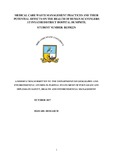Please use this identifier to cite or link to this item:
https://cris.library.msu.ac.zw//handle/11408/2973| Title: | Medical care waste management practices and their potential effects on the health of human scavengers at Inyathi District Hospital dumpsite | Authors: | Ngole, Nyladzi | Keywords: | Medical waste practices Human scavengers Health care waste management |
Issue Date: | 2017 | Publisher: | Midlands State University | Abstract: | The research sought to investigate medical waste practices and their potential effects on human scavengers at Inyathi District Hospital dumpsite. Qualitative research design was used in answering the objectives of this study. Thirty health workers were randomly sampled at the hospital whilst purposive sampling was employed in selecting the key informants from Ministry of Health, Inyathi Hospital and Bubi RDC. Questionnaires for health workers, interview guide for scavengers and key informants and observations were used for data collection. Data collected was analysed using Epi Info, presented in frequency distribution tables, and bar graphs. The research found out that waste generated at Inyathi district hospital was composed of used gloves, used needles, used scissors, soiled bandages and gauze, soiled linen general waste and stationery collected into few bins not colour coded. Through this research dumping, incineration, burning, ottoway and sewerage of liquid waste were identified as the waste management practices practiced at Inyathi District Hospital. It was established that scavengers collect used scissors, used gloves, sputum bottles, glass and plastic bottles, linen and some general waste for reuse and resale to unsuspecting surrounding communities as well as nearby mines. On assessment acute respiratory infections, skin conditions, cuts and needle prick were the effects of medical care waste to scavengers. With the above findings it was noted that with enough waste receptacles colour coded, medical care waste workers trained waste disposal method would be of no harm to humans. Colour coding of waste receptacles, segregation of waste at source, training of health care waste workers is lacking. Waste management practices used at the hospital is burning which happens mainly at the dumpsite as much of the waste find its way to the dumpsite. Decommissioning of the dumpsite and putting waste in a secure refuse pit at the hospital a better practice. Awareness and training of scavengers recommended to be done to ensure they are not exposed to effects of medical care waste. Health care waste management to be centralised at the hospital as a way of stopping scavenging. | URI: | http://hdl.handle.net/11408/2973 |
| Appears in Collections: | Postgraduate Diploma In Safety, Health And Environmental Management |
Files in This Item:
| File | Description | Size | Format | |
|---|---|---|---|---|
| Ngole Final Research EDITED.pdf | Full Text | 832.13 kB | Adobe PDF |  View/Open |
Page view(s)
126
checked on Apr 4, 2025
Download(s)
510
checked on Apr 4, 2025
Google ScholarTM
Check
Items in MSUIR are protected by copyright, with all rights reserved, unless otherwise indicated.



